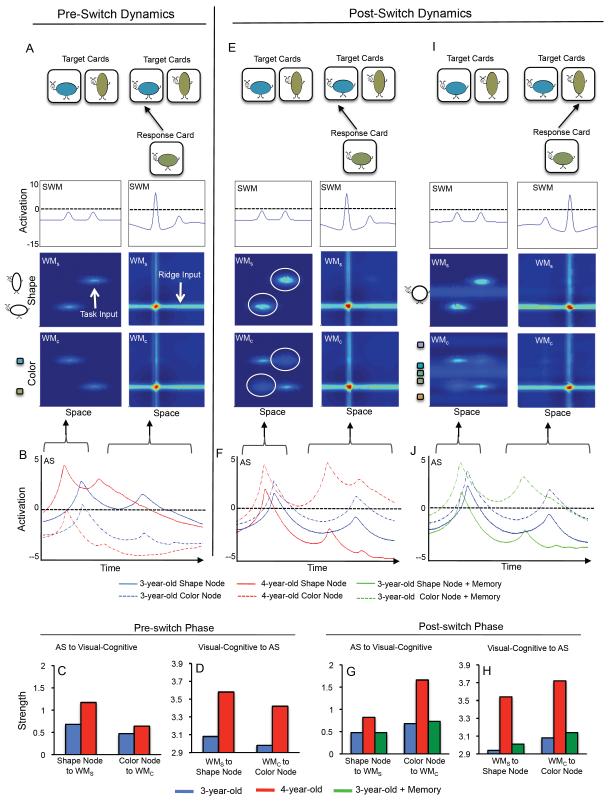Figure 1.
Shows DNF model dynamics for 3- and 4-year-old models in DCCS task. Panel A shows the model dynamics during the pre-switch phase. Initially, the model is situated in front of target cards depicting a short, blue object and a tall, green object. This generates task inputs in SWM (see “bumps”) and WMS and WMC (see light blue patches). The model is instructed to sort the short, green object depicted on the response card by shape. This leads the shape node in the attention system (AS) to become active for the 3- and 4-year-old models (see solid blue and solid red lines in B). Consequently, the strength of the connectivity between the AS and the visual-cognitive system is stronger for shape than color node (compare left portion to right portion of C-D). It is also stronger for the 4-year-old than 3-year-old model (compare red bars to blue bars in C-D). This reflects the stronger connectivity in the 4-year-old than 3-year-old model (see text). These interactions between the AS and visual-cognitive system lead the model to sort by shape by forming activation peaks in WMS, WMC, and SWM at the left location. Note that the arrows shown from the AS to the visual-cognitive system indicate the window of time that AS activity corresponds to the onset of a trial (left portion of A) and the sorting of the card (right portion of A).
Panel E shows the DNF model dynamics during the post-switch phase. The model is instructed to sort the short, green object by color. This leads the color node in the AS to become active for the 3- and 4-year-old models (see dashed blue and dashed red lines in F). During the post-switch phase, the strength of the connectivity between the AS and visual-cognitive system is stronger for color than for shape (compare right portions of G-H). It is also stronger for the 4-year-old than the 3-year-old model (compare red to blue bars in G-H). Importantly, for the 3-year-old model, this connectivity is too weak for WMC to overcome the robust Hebbian memories acquired from sorting by shape during the pre-switch phase in WMS (see white circles). The 3-year-old model continues to sort the short, green object to the left location by shape. The 4-year-old model sorts by color (not shown).
Panel I shows the 3-year-old model during the post-switch phase after it has acquired experience in the form of Hebbian memories with the dimensional label ‘color’ in the AS and 5 objects that differ in color (see distributed light blue patches in WMC) and share one shape (see light blue ridge in WMS). This experience primes WMC to respond more strongly during the post-switch phase. It also creates a stronger pattern of connectivity from the AS to the visual-cognitive system for color than shape (green bars in G) and from the visual-cognitive system to the AS for color (green bars in H) than in the 3-year-old model alone for color (blue bars in G-H). This is also reflected in the strength of the color node in the AS, which is stronger for the 3-year-old + memory model than 3-year-old model alone (compare dashed green line to dashed blue line in the AS in J). The 3-year-old model switches attention across dimensions and sorts the short, green object to the right location based on color in the post-switch phase.

